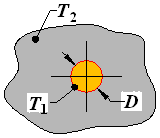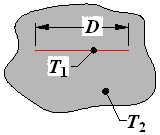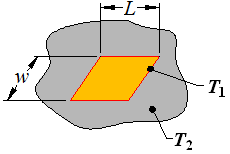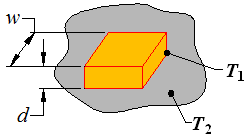| System
| Schematic
| Active Area, As
| qss*
|
Case 1
Isothermal sphere of diameter D and temperature T1 in an infinite medium of temperature T2 |
 |
πD 2 |
1 |
Case 2
Infinitely thin, isothermal disk of diameter D and temperature T1 in an infinite medium of temperature T2 |
 |
|
|
Case 3
Infinitely thin rectangle of length L, width w, and temperature T1 in an infinite medium of temperature T2 |
 |
2wL |
0.932 |
Case 4
Cuboid shape of height h with a square footprint of width w and temperature T1 in an infinite medium of temperature T2 |
 |
2w 2 + 4wd |
| qss* |
| 0.1 | 0.943 |
| 1.0 | 0.956 |
| 2.0 | 0.961 |
| 10 | 1.111 |
|



